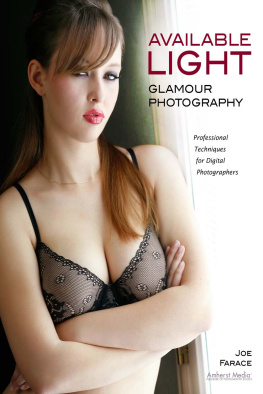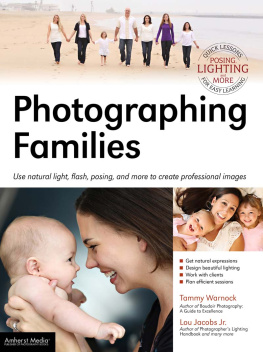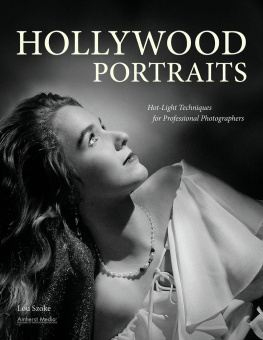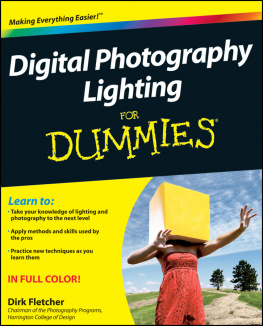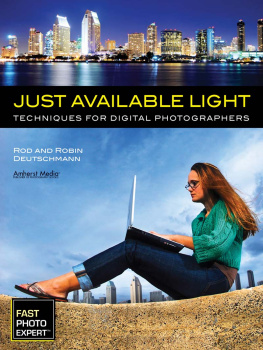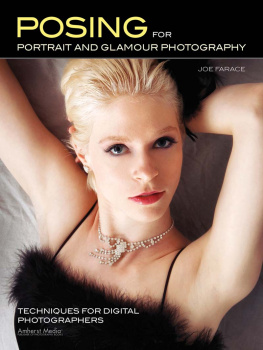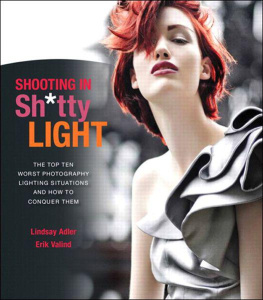DEDICATION
This book is dedicated to the one person in my adult life that has both inspired me and made me supremely happy. Besides being the most loving and caring person that I know, shes also a great photographer. Thats why this book is dedicated to my wife and best friend, Mary Farace.
Check out Amherst Medias blogs at:
http://portrait-photographer.blogspot.com/
http://weddingphotographer-amherstmedia.blogspot.com/
Copyright 2013 by Joe Farace.
All photographs by the author unless otherwise noted.
All rights reserved.
Published by:
Amherst Media, Inc.
P.O. Box 586
Buffalo, N.Y. 14226
Fax: 716-874-4508
www.AmherstMedia.com
Publisher: Craig Alesse
Senior Editor/Production Manager: Michelle Perkins
Assistant Editor: Barbara A. Lynch-Johnt
Editorial assistance provided by Sally Jarzab, John S. Loder, and Carey A. Miller.
ISBN-13: 978-1-60895-524-4
Library of Congress Control Number: 2012936507
Printed in the United States of America.
10 9 8 7 6 5 4 3 2 1
No part of this publication may be reproduced, stored, or transmitted in any form or by any means, electronic, mechanical, photocopied, recorded or otherwise, without prior written consent from the publisher.
Notice of Disclaimer: The information contained in this book is based on the authors experience and opinions. The author and publisher will not be held liable for the use or misuse of the information in this book.
CONTENTS





A CKNOWLEDGMENTS
T his book completes a trilogy of books about lighting, glamour photography, and portraiture that began with Joe Faraces Glamour Photography and continued with Studio Lighting Anywhere. Books like these are not produced in a vacuum, and many different people helped make them possible. A big thank you goes out to editor Michelle Perkins for suggesting the concept and to Amherst Medias dynamic publisher Craig Alesse for giving me a chance to write all of these books. Thanks also to Barbara A. Lynch-Johnt for her superb editing skills.
Thanks also go out to the companies who offered technical assistance and product shots for this book, including Adoramas (www.adorama .com) Jerry Deutsch, Booth Photos (www.boothphoto.com) Jeff Cowdrey and Sheila Tait, Mark Astmann of Manfrotto Distribution (www.manfrottodistribution.us), Westcotts (www.fjwestcott.com) Amber McCoy and Jennifer Holts-berry, as well as the creative staff at Grin&Stir (www.lightwaredirect.com).
In my first two books, I asked several guest photographers to contribute images, but for this one there are fewer. Barry and Matthew Staver contributed images to the chapter on using reflectors, and my wife Mary Farace not only made some of the pictures in this book but was kind enough to pose for a few of them as well. And thats also why a big thank you goes out to all of the people who posed for the photographs that appear in this book. Photographing peopleno matter what kind of lighting you useis a shared endeavor, and I owe a huge debt of gratitude to all of them.
I would also like to thank my personal support team, who encourage as well as bail me out of technical and creative problems. This includes photographer Barry Staver (www.barrystaver.com) and technical guru Kevin Elliott of DigitalMD (www.digitalmd.net).
Lastly, I would like to thank my wonderful wife Mary who is an outstanding people photographer in her own right and who over the years has taught me a lot about lighting. Mary has been and is my greatest fan and is as much responsible for whats in this book as anyone. I will always be grateful for her love and support.
A UTHOR B IOGRAPHY
J oe Faraces interest in digital imaging combines an engineering education from Johns Hopkins University with training in photography he acquired at the Maryland Institute, College of Art. Joe is the author of many books about photography, digital imaging, and the business of photography, and this one represents the thirty-second book hes published. He is Contributing Writer and Photographer to Shutterbug magazine, which also publishes his monthly Digital Innovations and Web Profiles columns. His writing also occasionally appears in other domestic and foreign magazines. Joes honors include the Photographic Craftsmans Award, presented by the Professional Photographers of America, and honorary membership from the Independent Photographers of Colorado for dedication and services to the photographic community.
Please visit Joes daily how-to blog (www.joefaraceblogs.com) where he posts a photographic tip, tool, or technique. You can follow Joe on Twitter at www.twitter.com/joefarace.

My wife made this available light portrait of a slightly heavier me outside our favorite Mexican restaurant in Denver using the brick column as a gobo to block the harsh light from the left. To capture the image she used an Olympus E-500 with Zuiko Digital ED 40-150mm lens. The exposure was 1/50 second at f/5.6 and ISO 100. 2011 Mary Farace. (As you can see, the techniques in this book can be applied to subjects that may not fit into the glamour genre.)
I NTRODUCTION
P ORTRAITS ARE THE MOST INTIMATE PHOTOGRAPHS.
T HE IMAGE WILL SURVIVE THE SUBJECT -V ICTOR S KREBNESKI
W hen you look at photographs of people in magazines, books, newspapers, or on your iPad, do you notice how some imagesmore than othersgrab your attention? These special photographs force you to take a second look and you may even wonder how they were made. My goal for this book is to take you behind the scenes and show you how a number of natural light portraits were created and, in the telling, help you improve your own available light photographs.

One of the tools that will be discussed later in the book is the use of wide aperture lenses such as the f/1.4 Planar Carl Zeiss 50mm T* lens that was used to make this low-light portrait. The camera used was a Canon EOS D60. The exposure was 1/80 second at f/6.3 and ISO 400.

Shooting portraits under the kind of mixed industrial lighting conditions that you typically encounter in factories is a challenge too. This available light image was made using a Canon EOS 10D and EF 28-105mm f/3.5-4.5 lens. The exposure was 0 second at f/4 and ISO 800. Increasing the cameras ISO setting (something thats covered later in the book) compensated for the low-light condition.
Sometimes your best portraits will be made with available light, unavailable light, available darkness, low light, or whatever euphemism you prefer. It doesnt matter what you call any of these challenging lighting conditions; the truth is that theres something rewarding about the process. First, there is the thrill of overcoming technical obstacles that normally prevent you from producing a well-exposed image. Second, photos made under conditions different from the f/16 and the sun over your right shoulder instruction-sheet standard have a more eye-catching look. Third, since most photographs are made during the middle of the day, taking the time to search out other than normal lighting conditions can produce images that look different from those made by the rest of the pack. And thats just outdoors. Just as challenging can be the prospect of working indoors under a combination of various light sources.
Next page
